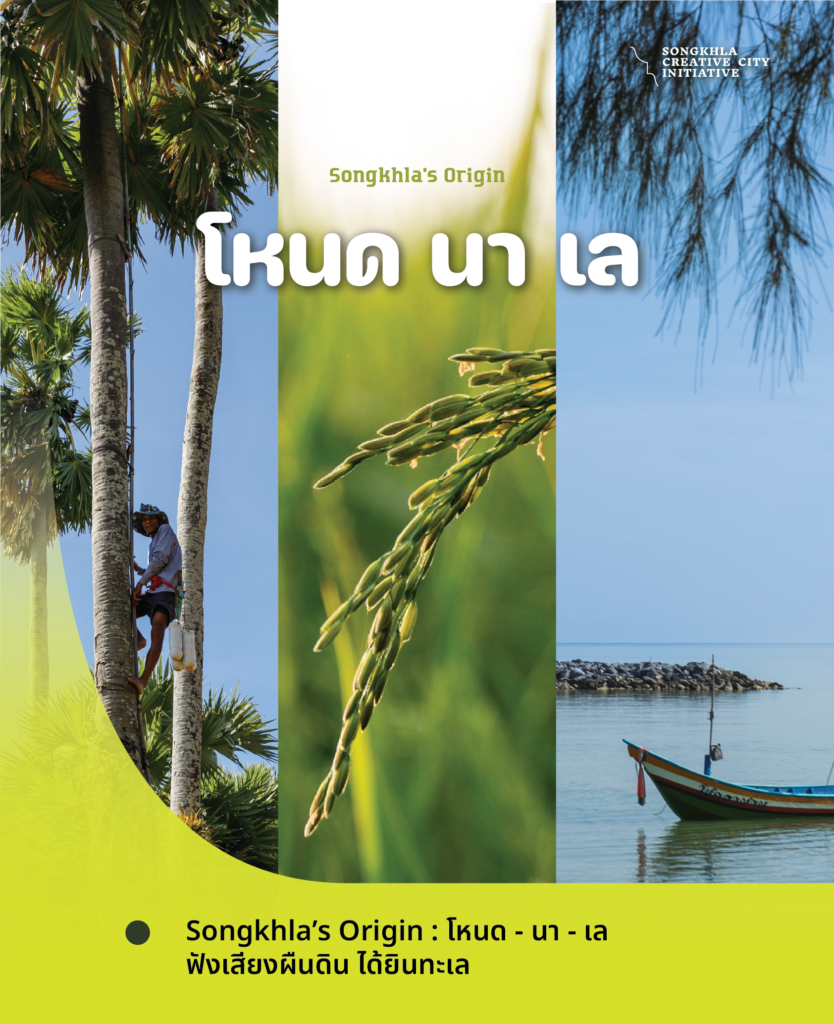Nod - Na - Lae

Listen to the land, hear the ocean
Day by day, understanding and realizing oneness, connection, and awareness of sensitivity, heat and cold,
the connection between ourselves and our environment is becoming weaker and weaker, empathy with nature is becoming distant and lost in the rush of time to fulfill various desires.
I don’t like to use the term ‘good luck’, but today we still maintain some legacy of the connection between people and nature for us to observe, be aware of, and learn about, so that we can re-establish a harmonious relationship with nature. A familiar example to Southern people is Nod-Na-Lae.
Node-Na-Lae is evidence of an understanding and personal connection with nature – listening to the land, hearing the ocean – in addition to production methods for ‘raw materials’ used as food ingredients by Songkhla and Southern peoples.
Perhaps because the area is compact enough for people to comprehend, Sathing Phra Peninsula, which comprises Songkhla Lake and the peninsula land in the Gulf of Thailand, ranging from 5 to 12 kilometers in width and around 70 kilometers in length, provides an example of the understanding of nature, applied by the people here as use of the land for agricultural practices and coastal fisheries, or “Nod-Na-Lae”, in a harmonious and unified relationship.
Nod – Sugar Palm
There is perhaps no clear evidence for when “tal tod” first arrived in the area. However, it is believed that palm trees may have already been present in Southeast Asia for thousands of years. Southern people, and Thai people from other regions, know how to make best use of every part of the palm tree. The saying “tal tod has many benefits” is not an exaggeration. There are millions of palm trees in Sathing Phra, and the people here rely on the production of palm sugar both for primary and secondary sources of income. Those who make their living from palm trees are at work every day, starting in the morning to cut inflorescences, replace sugar containers and transport them home. In the afternoon they repeat this. The amount of sugar, taste, and quality are dependent on the season. Throughout the day, the fires are carefully watched and extra wood added to boil and process the sugar. Whenever free time is available, it is mostly spent visiting the farms and orchards. The way of life of the palm tree begets profound wisdom in the use of the palm tree and its fruit, to produce both utensils and local cuisine, as well as development of suitable tools to perfection. There is a joke, that you shouldn’t look for trouble with someone who climbs palm trees because of the palm knife they carry around their waist. Although the blade is not large, it is famous for its sharpness. The tough palm tree inflorescence can be cut off with a single strike. So don’t even try it!
Rice – Way of Farming
ภูมิปัญญาและวิถีการทำนา คือรูปแบบและรายละเอียดการทำเกษตรที่แตกต่างกันไปแต่ละพื้นที่ คนใต้สมัยก่อนก็มีวิถีการทำนาไม่เหมือนใคร เริ่มจากข้าวพันธุ์พื้นบ้าน อย่าง ไข่มด เล็บนก นางพญา หอมจันทร์ นางหมรุย และสังหยด รสชาติเนื้อสัมผัส ความหอมมัน อร่อยที่แตกต่างจากภูมิภาคอื่น นาทางใต้แต่ก่อนเป็นนาน้ำฝน ต้องรอฤดูกาล เข้าอกเข้าใจดินฟ้าอากาศ มีทั้งปลูกเป็นนา และปลูกสลับกับสวนผลไม้ และสวนยาง เมื่อข้าวสุกคนสทิงพระและลุ่มวัฒนธรรมนี้จะใช้แกระ หรือแกะ (เครื่องมือเกี่ยวข้าวเป็นแผ่นไม้รูปสี่เหลี่ยมคางหมูขนาดพอให้จับได้ในฝามือ ด้านหนึ่งจะมีคมมีดใช้ตัดรวงข้าว) เกี่ยวข้าวทีละรวง ก่อนจะมัดเป็นกำเรียกว่า ‘เรียง’ แล้วนำไปตี มีบันทึกว่าในระยะหลังที่แรงงานขาดแคลนและค่าแรงรายวันสูงขึ้น คนในคาบสมุทรฯ และภาคใต้แถบนี้จึงเริ่มหันมาใช้เคียว และรถเกี่ยวข้าว เพื่อประหยัดเวลา เช่นเดียวกับการสีข้าวแบบโบราณที่ใช้ครกเรียก ‘ครกสีหมุน’ ซึ่งเมื่อสีแล้วจะได้ข้าวที่มีคุณค่าทางโภชนาการสูง ที่ ณ ปัจจุบันก็แทบไม่เหลือให้พบเห็นแล้ว
Lae – Local Fishing Style
The wisdom and knowledge of local fisheries, passed down from generation to generation, is based on an understanding of the unique characteristics of the lake and two adjacent seas: Songkhla Lake (upper, middle and lower parts (Songkhla Lake – Thalae Luang)), the Gulf of Thailand, and Andaman Sea. This understanding encompasses conditions of fresh water, brackish water, and salt water, coastal topography, beaches, mangroves, river deltas, precise reading of changes in wind, ocean currents and tides, growth and foraging behavior of aquatic animals both diurnal and nocturnal, seasonal cycles of growth, mating and spawning, environments and suitable areas for placing fishing equipment, and timing to hunt aquatic animals, including catching and fishing methods that consider sustainable growth and catching of subsequent generations of aquatic creatures.
Furthermore, local understanding includes development of environmentally-friendly tools, food preservation and product processing methods, as well as knowledge of local ingredients and combination into local recipes. Node-Na-Lae is evidence of an understanding and personal connection with nature – listening to the land, hearing the ocean – in addition to production methods for ‘raw materials’ used as food ingredients by Songkhla and Southern peoples.